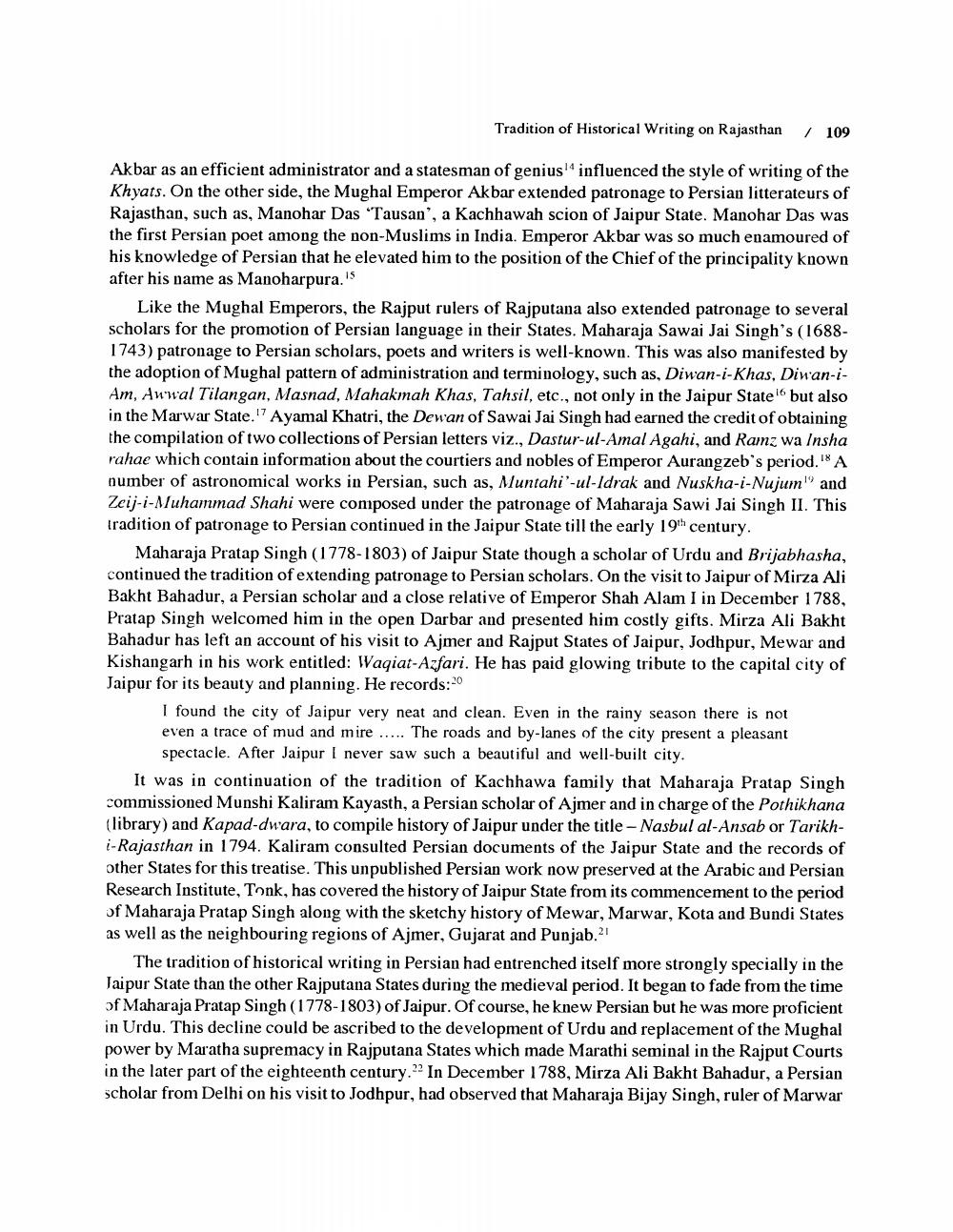________________
Tradition of Historical Writing on Rajasthan
/
109
Akbar as an efficient administrator and a statesman of genius' influenced the style of writing of the Khyats. On the other side, the Mughal Emperor Akbar extended patronage to Persian litterateurs of Rajasthan, such as, Manohar Das "Tausan', a Kachhawah scion of Jaipur State. Manohar Das was the first Persian poet among the non-Muslims in India. Emperor Akbar was so much enamoured of his knowledge of Persian that he elevated him to the position of the Chief of the principality known after his name as Manoharpura.'
Like the Mughal Emperors, the Rajput rulers of Rajputana also extended patronage to several scholars for the promotion of Persian language in their States. Maharaja Sawai Jai Singh's (16881743) patronage to Persian scholars, poets and writers is well-known. This was also manifested by the adoption of Mughal pattern of administration and terminology, such as, Diwan-i-Khas, Diwan-iAm, Auwal Tilangan, Masnad, Mahakmah Khas, Tahsil, etc., not only in the Jaipur State but also in the Marwar State.17 Ayamal Khatri, the Dewan of Sawai Jai Singh had earned the credit of obtaining the compilation of two collections of Persian letters viz., Dastur-ul-Amal Agahi, and Ramz wa Insha rahae which contain information about the courtiers and nobles of Emperor Aurangzeb's period. A number of astronomical works in Persian, such as, Muntahi'-ul-Idrak and Nuskha-i-Nujum and Zeij-i-Muhammad Shahi were composed under the patronage of Maharaja Sawi Jai Singh II. This tradition of patronage to Persian continued in the Jaipur State till the early 19th century.
Maharaja Pratap Singh (1778-1803) of Jaipur State though a scholar of Urdu and Brijabhasha, continued the tradition of extending patronage to Persian scholars. On the visit to Jaipur of Mirza Ali Bakht Bahadur, a Persian scholar and a close relative of Emperor Shah Alam I in December 1788, Pratap Singh welcomed him in the open Darbar and presented him costly gifts. Mirza Ali Bakht Bahadur has left an account of his visit to Ajmer and Rajput States of Jaipur, Jodhpur, Mewar and Kishangarh in his work entitled: Waqiat-Azfari. He has paid glowing tribute to the capital city of Jaipur for its beauty and planning. He records:20
I found the city of Jaipur very neat and clean. Even in the rainy season there is not even a trace of mud and mire ..... The roads and by-lanes of the city present a pleasant
spectacle. After Jaipur I never saw such a beautiful and well-built city. It was in continuation of the tradition of Kachhawa family that Maharaja Pratap Singh commissioned Munshi Kaliram Kayasth, a Persian scholar of Ajmer and in charge of the Pothikhana (library) and Kapad-dwara, to compile history of Jaipur under the title - Nasbul al-Ansab or Tarikhi-Rajasthan in 1794. Kaliram consulted Persian documents of the Jaipur State and the records of other States for this treatise. This unpublished Persian work now preserved at the Arabic and Persian Research Institute, Tonk, has covered the history of Jaipur State from its commencement to the period of Maharaja Pratap Singh along with the sketchy history of Mewar, Marwar, Kota and Bundi States as well as the neighbouring regions of Ajmer, Gujarat and Punjab.21
The tradition of historical writing in Persian had entrenched itself more strongly specially in the Jaipur State than the other Rajputana States during the medieval period. It began to fade from the time of Maharaja Pratap Singh (1778-1803) of Jaipur. Of course, he knew Persian but he was more proficient in Urdu. This decline could be ascribed to the development of Urdu and replacement of the Mughal power by Maratha supremacy in Rajputana States which made Marathi seminal in the Rajput Courts in the later part of the eighteenth century. In December 1788, Mirza Ali Bakht Bahadur, a Persian scholar from Delhi on his visit to Jodhpur, had observed that Maharaja Bijay Singh, ruler of Marwar




